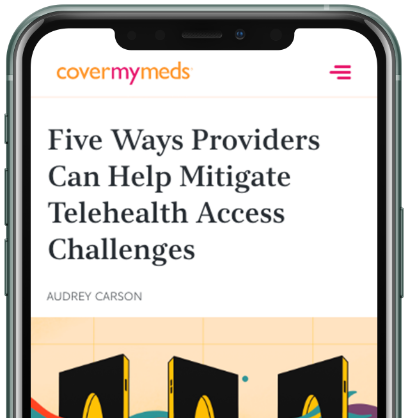5 Ways Care Teams Are Navigating 2025 Health Benefit Changes
For provider offices, the start of each new year means a surge in administrative work due to annual health insurance and benefit updates. Explore five strategies care teams can use to streamline their workflow and reduce manual processes in 2025.

During the first few months of the year, healthcare teams prepare for an influx of paperwork, phone calls and office visits due to formulary updates, new or revised health insurance plans, prior authorization expirations and patient deductible resets.
Navigating the extra administrative workload caused by these annual benefits changes is a crucial task that often falls on medical assistants and nurses. Their efforts help patients maintain access to their much-needed therapies and prevent disruptions in care.
So, how can care teams prepare for benefit changes in 2025? Here are five strategies to make health insurance and benefits changes feel more manageable.
1. UTILIZE ELECTRONIC PRIOR AUTHORIZATION TOOLS
Annual benefit or formulary changes can alter medication prior auth requirements, so healthcare teams must be especially vigilant to help patients maintain access to needed medications. By reducing reliance on manual methods like faxes and phone calls, healthcare teams can work more efficiently and focus more on patients.
Prioritizing the use of electronic prior authorization (ePA) tools that can be integrated with Electronic Health Records (EHRs) can help healthcare teams manage the seasonal influx of prior auth requests and help ensure timely medication access for patients.
2. ADOPT REAL-TIME PRESCRIPTION BENEFIT (RTPB) SOLUTIONS
During the annual reverification period, when numerous formulary and plan changes occur simultaneously, prior auth platforms with built-in RTPB technology is particularly useful, especially when it's integrated into an EHR. RTPB can provide real-time insights into a patient's medication coverage and costs, enabling healthcare teams to make swift, informed decisions that align with the patient’s latest insurance updates.
3. IMPLEMENT PROACTIVE PRIOR AUTHORIZATIONS
Given the influx of prior auth requests and renewal requirements at the start of the new year, prospective prior authorizations can help healthcare teams stay ahead of potential coverage issues. By addressing these needs proactively, healthcare teams can help minimize treatment disruptions and maintain patient satisfaction amidst the chaos of the prior auth season.
Factors That Impact Annual Benefits Changes
- Formulary Updates: Payers release annual formularies, which are comprehensive lists detailing the prescription drugs covered under their plans and the extent of that coverage, impacting medication access and affordability for patients.
- Employer-Sponsored Insurance Resets: Many employer, government and institutional health insurance plans reset annually, affecting coverage levels and prior auth requirements.
- Deductible and Out-of-Pocket Maximum Resets: At the beginning of a new plan year, patient deductibles and out-of-pocket maximums reset, impacting affordability and access to care.
- Economic Factors and Affordability: Changes in income, employment status and economic conditions
4. RESERVE EXTRA TIME FOR GLP-1 PRIOR AUTHS
As GLP-1 drugs have gained popularity as a treatment for diabetes and weight management, prior auth challenges for healthcare teams have also increased. Prior auth for GLP-1s often involve complex documentation, with different criteria across payers. With real-time access to insurance requirements through RTPB technology, ePA can help overcome these barriers and prevent disruptions in medication access.
5. KEEP PATIENTS UPDATED ON PRIOR AUTH OUTCOMES
Effective communication is crucial during the prior auth season, as keeping patients informed can prevent confusion and ensure smooth transitions. Signing patients up for automated text and email notifications on prior auth determinations, with their consent, can be particularly useful in reducing phone calls while increasing patient satisfaction.CoverMyMeds data on file for approved prior authorizations, 2022
Break down your prior auth barriers
At CoverMyMeds, we’re dedicated to providing insight and technology to help healthcare teams break down medication access and affordability barriers for their patients. Over a decade ago, CoverMyMeds transformed the prior auth process, replacing the time-consuming manual methods with a modern electronic version. Today, CoverMyMeds is the go-to solution for ePA for more than 950,000 providers.CoverMyMeds data on file, 2024
CoverMyMeds’ solutions work for all drugs, including specialty medications, and all health plans and PBMs, including Medicare Part D and Medicaid. Our digital solutions, including ePA and specialty patient support services, are available at no cost to prescribers and their staff.
Beyond simplifying the cumbersome prior auth process, CoverMyMeds has built an expansive suite of tech-enabled solutions to help solve some of the most common medication access and affordability challenges faced by patients. Our network connects providers, pharmacies, pharmaceutical companies and payers to help patients get the medicine they need to live healthier lives.
Ready to get started using CoverMyMeds for prior authorizations?
Questions about our website? Read our “Quick Guide to CoverMyMeds Prior Authorization Requests.”
The latest healthcare insights, floated right to your inbox.



